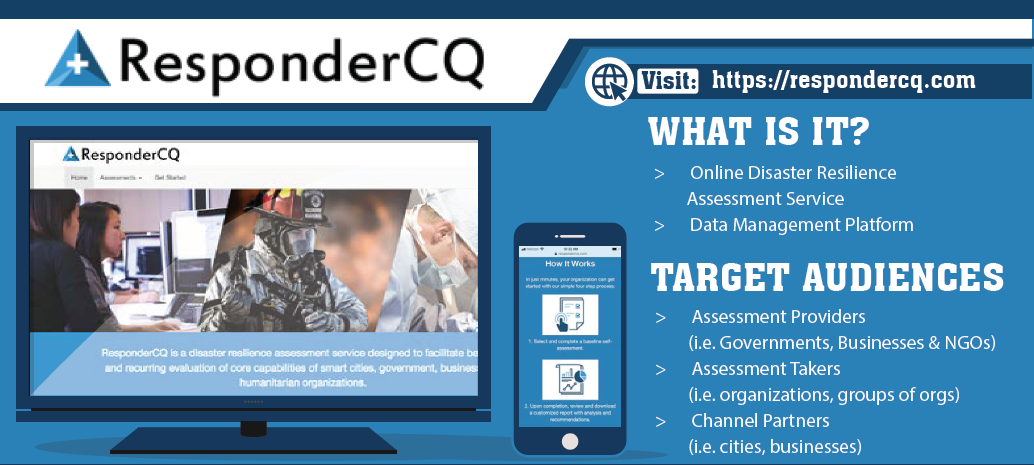
Disaster response has dominated headlines for years, and technologies to enhance disaster response capabilities are rapidly emerging. Now, a new global dialogue is centering on resilience—how we not only come together to help communities quickly recover, and even thrive, post-disaster, but how we strengthen their defenses against future threats. Every community is different, and there is no one-size-fits-all solution when it comes to improving disaster resilience, thus it is difficult to measure and assess. However, the academic research community holds a consensus view that the ability to measure improvements based on a maturity model-based approach will help guide communities down a path that will enhance their resilience to multi-jurisdictional disasters.
To address this challenge, the Department of Homeland Security (DHS) Science and Technology Directorate (S&T) funded the development of guidance and tools to help communities measure their “Capability Quotient (CQ),” which is the readiness to respond to risk and to respond to disruptionsof any kind.
DHS S&T and industry partner SPIN Global began working on this guidance in 2016. In that time, they published an assessment framework, developed ResponderCQ.com, and initiated a ‘global disaster resilience assessment community of practice’ in collaboration with the Rockefeller Foundation and Tulane University’s Disaster Resilience Leadership Academy (DRLA).
“This evidence-based approach provides a necessary link between academic, operational and technical stakeholders, and provides a roadmap for continued research and development.” said Reggie Ferreira PhD, Director of Tulane University’s Disaster Resilience Leadership Academy.
Today, ResponderCQ is globally available and is in use by cities, countries, businesses and non-governmental organizations.
Designed to Work Across Borders
ResponderCQ was designed to support cross-border collaboration at local, regional or multi-national levels. For example, ResponderCQ offers an online “Crisis Information Management” assessment for governments, which is a modified version of DHS S&T’s Incident Management Information Sharing Capability Maturity Model and the DHS SAFECOM Interoperability Continuum. Building on the lessons learned from S&T’s bilateral efforts, such as the Canada-U.S. Enhanced Resiliency Experiment Series (CAUSE), the assessment tool was initially piloted in conjunction with NATO’s Next-Generation Incident Command System (NICS) in Bosnia and Herzegovina, Croatia, Macedonia, and Montenegro. The tool enabled NATO program participants to conduct assessments of crisis information management capabilities and informed development of a country-specific and multi-national program roadmap.
“ResponderCQ is applicable across a range of S&T priorities, from our multinational efforts with NATO NICS to our flood programs in South Carolina,” explained S&T Program Manager Ronald Langhelm. “This tool helps provide a realistic assessment of whether efforts to improve resilience are in fact doing so. This is a tremendous help for communities that must decide how to assign resources, whether it is to continue in their current improvement efforts or to try a new approach to enhance resilience.”
Designed for Cities
In a 100 Resilient Cities survey, the top need identified was a request for assistance with implementing and measuring disaster resilience. DHS S&T and SPIN Global collaborated with the Rockefeller Foundation’s 100 Resilient Cities program to develop and test a service delivery model that rapidly measure various components of a city’s existing resilience strategies.
Mike Mendonca, Chief Resilience Officer for Wellington, New Zealand, shared that his city used ResponderCQ to “better understand where our strengths are with respect to geographic information systems (GIS) and resilience information management, and more importantly where our weaknesses are and where we have gaps.” Knowing what is not working is as essential to improving overall resilience as knowing what does work well.
The District of Columbia Homeland Security and Emergency Management Agency (HSEMA) used ResponderCQ to provide a business continuity assessment and facilitate outreach.
“HSEMA, DHS S&T and SPIN Global hosted a workshop for local small and medium sized businesses. The workshop used the ResponderCQ tool, which is a quick and easy way for business owners to assess their ability to respond to and recover from business disruptions,” said Adam Baron, Private Sector Liaison for HSEMA. “The workshop also let business owners discuss their concerns, share best practices and walk away from the workshop feeling more prepared.”
In addition, many businesses in cities throughout the Mid-Atlantic region conducted a “Crisis Information Management” assessment based on S&T’s model during FEMA’s 2018 National Level Exercise.
Modernizing Paper-Based Approach
The ResponderCQ platform is mobile-ready and powered by a statistical database and analytics engine that is capable of supporting conversion of paper-based assessments into an online experience. ResponderCQ assigns the user or group of users a quantitative score along with recommended actions to improve resilience. Scores improve when recommended actions are implemented and reported.
Using the ResponderCQ platform enables users to navigate a simple four-step process and allows assessment providers to more efficiently and effectively manage the assessment lifecycle. The process is designed to truncate typical paper-based assessment processes that may take weeks to complete and assess into an experience that can be completed in just minutes, yielding both tangible products and defensible results.
The user experience is as follows:
- select and complete a self-assessment;
- immediately review and download a report with analysis and next steps;
- access downloadable resources from the online toolkit; and
- schedule or initiate a re-assessment.
The assessment provider may offer an assessment to specified organizations and groups, and can produce group reports, conduct trend analysis, and obtain other insights that will help inform program management.
Tangible and Defensible Outcomes
ResponderCQ is intended to provide a baseline assessment of a community’s resilience and then monitor progress over the course of 2-5 years. With the aid of ResponderCQ, communities are better able to jointly plan, coordinate and manage response to risk and to incidents as they arise. By having better information available as they plan, communities that mitigate their risk will experience reduced costs for both response and recovery while enhancing their resilience and will be able to use progress reports to substantiate funding needs and portray outcomes.
Ronald Langhelm noted, “This tool changes the way communities used to plan for and respond to risks. Now, ResponderCQ guides their decisions on how to improve resilience efforts.”

